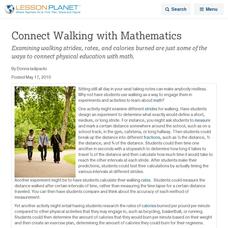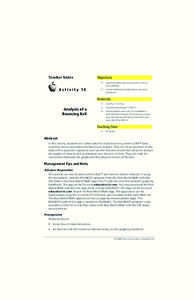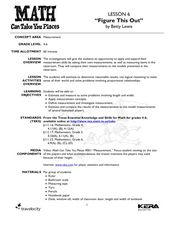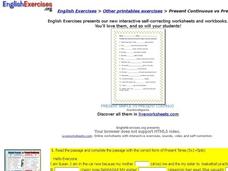Curated OER
Dribbling Math
Students practice adding, subtracting and multiplying numbers while working on dribbling skills. They play the role of munchers and dribblers while adding, subtracting and multiplying numbers from a deck of cards.
Curated OER
Connect Walking with Mathematics
Examining walking strides, rates, and calories burned are just some of the ways to connect physical education with math.
University of Utah
Integer Exponents, Scientific Notation and Volume
A one-stop resource for exponents, square and cube roots, scientific notation, and volume formulas guides learners through properties of exponents. As they learn to apply these properties to operations with scientific notation,...
Curated OER
Exploring Scale And Ratio
Learners measure the actual size and distance of the solar system using scale and ratio. They watch and discuss a video, create a distance-scale solar system model, and compare the scale sizes of planets to their actual sizes.
Curated OER
Tennis Ball Tubes
Learners determine whether the height of a tennis ball tube or the distance around the tube is greater, or whether they are the same. Using the formula for the circumference and diameter of a sphere, they discuss the word problem, and in...
Curated OER
Sorting and Classifying
Fifth graders are engaged in sorting and classifying geometric shapes of various colors and sizes. They discuss the properties of these shapes and illustrate a range of classifications using Venn diagrams.
Curated OER
Shots, Standings, and Shopping
Rates and ratios can easily be applied to real-world situations. Learners explore a series of websites in order to procure comparable data. They define ratios and rates, view videos, and use the internet to explore how ratios and rates...
Curated OER
After School Snacks
In this after school snacks instructional activity, students look at food labels and determine how much "phe" is in foods. Students complete 22 problems total.
Curated OER
Chances Are: Talking Probability
Students explore probability and the process of data analysis and predictions. They participate in two activities, one involving a calculator and one the Internet, in which they make predictions and conduct activities to test their...
Curated OER
Parabolas in Flight
Young scholars utilize a trajectory formula in order to discover the physics of a thrown ball. In this physics lesson, students videotape the trajectory of a thrown ball or basketball shot and analyze the action by breaking the...
Curated OER
How Can You Detect the Invisible?
Students participate in a lab activity in which they examine the characteristics of radon. They identify radon's link to cases of lung cancer. They complete a radon fact sheet and answer questions to end the lesson.
Curated OER
Find a Pattern
For this pattern worksheet, students use a table to solve a set of 3 word problems, then write their own problem using information in the table.
Curated OER
Bouncing Ball Experiment
Students collect data for a bouncing ball and select one bounce to analyze. They explore the relationship between velocity, position and acceleration. They seek out connections between the graphs and the physical motion of the ball.
Curated OER
Shaquille O'Neal Hand/Foot Span
Eighth graders measure foot length and hand span in this experiment to determine the ratio. They apply the ratio to determine Shaquille O'Neal's hand span if given his shoe size.
Curated OER
Decimal Stories
In this decimal instructional activity, students fill in decimal numbers in a story, choosing from a "decimal box" at the top of the page, filling in blanks so that the story makes sense.
Curated OER
Chances Are-Part 1
Students are introduced to the idea of probability by discussing the likelihood of events occurring. Pupils describe events that are certain, impossible, likely, and unlikely to occur. They determine the likelihood of an event occurring...
Curated OER
Figure This Out
Students measure different parts of the human body. In this measurement lesson, students work in pairs to take measurements of human measurements which include: arm span, height, foot length, and wrist to longest finger. They also...
Curated OER
On the Road Again
Young scholars work with patterns to develop formulas that will help them determine total cost. In this patterning instructional activity, students watch a video about an NBA trainer. (not included) They work in groups to access the...
Curated OER
Get On Board
Students create a ticket table illustrating the cost of tickets by alternative transportation. In this number sense lesson, students write number sentences to compare and contrast difference information in their chart. Students figure...
Curated OER
Explore the Elements of Art
Students recognize elements of art such as texture, shape line and color. In this elements of art lesson, students create a still life picture with oil pastel or crayons. Students define elements of art vocabulary....
Curated OER
Present Continuous vs Present Simple
In this present continuous and present simple learning exercise, students fill in the blanks to sentences with words in the present continuous and present simple tense and match questions to answers. Students complete 3 activities.
Curated OER
Investigation: Sorting and Classifying
Fifth graders explore geometry by creating shapes with construction paper. For this shape characteristics lesson, 5th graders identify the different attributes that make up specific shapes and create them using construction paper,...
Curated OER
Courts of Measure
Students practice their area and perimeter measurement. In this measurement lesson plan, students watch a video about perimeter and area. Students measure a gym for perimeter and area. Students write number sentences for the area and...
Curated OER
Springy Legs
Fifth graders measure their body height and the height they can jump. They use these measurements in forms of ratios, fractions and decimals to describe their Springy Legs Factors (SLF). Students compare their SLFs to other people's...

























